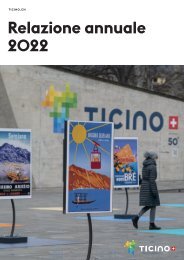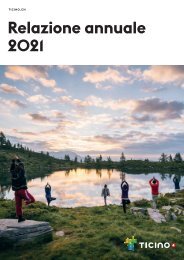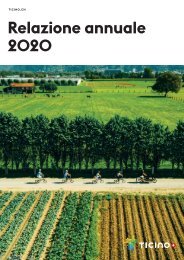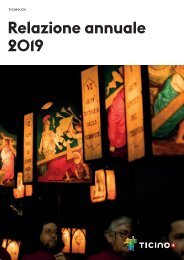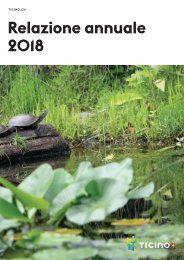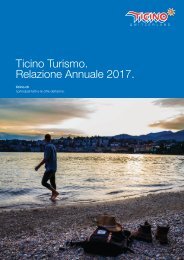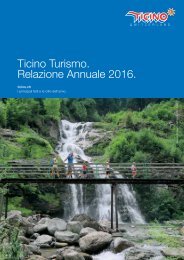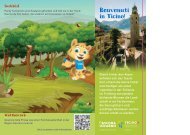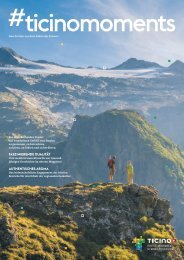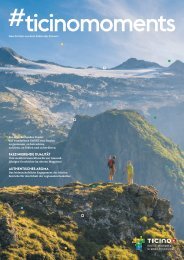#ticinomoments 2019
You also want an ePaper? Increase the reach of your titles
YUMPU automatically turns print PDFs into web optimized ePapers that Google loves.
MARVEL — CHIRONICO<br />
43<br />
CHIRONICO<br />
Magnesia powder<br />
on your hands<br />
and plasters on<br />
your fingers:<br />
bouldering makes<br />
your whole<br />
body work.<br />
Problems: that word is usually unpopular, but<br />
not among bouldering lovers. In their case, the<br />
more problems a route has, the better. At first,<br />
it's a bit strange to talk with Anja, Diego, Enea<br />
and Claudio because you have the impression<br />
that you're not understanding what they're<br />
talking about, but after a few minutes their<br />
enthusiasm and passion capture you and you<br />
feel the urge to find a nice boulder to climb.<br />
And if you're in Chironico, Cresciano, Brione<br />
Verzasca or anywhere in the Ticino valleys,<br />
you're in the right place!<br />
FROM SIMPLE TRAINING<br />
TO THE OLYMPICS<br />
But let's take a step back: what is bouldering?<br />
This sport discipline was born by coincidence<br />
in the early 20th century, south of Paris, in<br />
the forest of Fontainebleau, full of boulders<br />
and natural walls to climb. This area was used<br />
as a training area for climbing expeditions to<br />
conquer the peaks of the Alps. Those were<br />
the years of mountaineering tourism and the<br />
Grand Tour, from the Alps to the sea. Between<br />
1960 and '70, instead, bouldering became a true<br />
sport, thanks also to athletes like John Gill (a<br />
mathematician who is considered to be the<br />
father of bouldering). About 30 years ago, this<br />
discipline finally reached Ticino, where rocks<br />
and boulders abound. It's a real paradise for<br />
bouldering enthusiasts. Athletes from all over<br />
the world come to the Ticino valleys to tackle<br />
one of the many available open boulder routes.<br />
But the fame of these places hidden among the<br />
woods of the Leventina and other valleys is really<br />
due to an international – almost social – network<br />
of boulderers, who assign classifications based<br />
on levels of difficulty and skill of the athletes.<br />
1, 2, 6A, 7B +, 8C: you just need to take a look<br />
at the classification system of the various<br />
boulder routes to understand how diverse<br />
and structured this discipline is and while we<br />
observe our young friends, we understand that<br />
it is not only complex, but also difficult! So,<br />
it's not surprising that in the upcoming Tokyo<br />
2020 Olympic Games, sport as climbing and<br />
bouldering will be included.<br />
“IF SOMEONE HEARD US TALKING,<br />
THEY'D THINK WE'RE CRAZY”<br />
“Have you done the Delorean? And the Border<br />
Line?” “I got a handhold here, a reverse there, a<br />
stretch to reach that cleat, and then a throw...”<br />
At first it's certainly not easy to understand<br />
what Claudio, Enea, Anja and Diego are saying.<br />
Yes, because boulderers have their own private<br />
language, full of strange names (of the rocks<br />
and the routes on the various boulders) and<br />
verbs and expressions that are cryptic. But<br />
then, when Anja climbs the Doctor Med Dent<br />
in a few seconds, everything becomes clearer.<br />
Many things are fascinating in this activity:<br />
contact with nature, discovery of mysterious<br />
corners of a territory in which perfect boulders<br />
are hidden in a forest of maples and birches,<br />
the physical and mental challenge of the climb<br />
and contact with others boulderers (ranging<br />
from children to the young at heart) who are<br />
all part of a big family.





